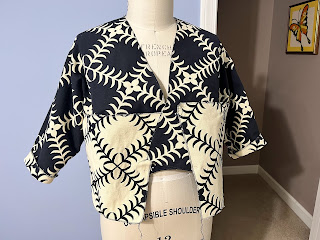Pattern: French Fold Shrug from Diane Ericson
This is a super interesting pattern designed by Diane some years ago. It has floated across my consciousness over the years and I finally decided to make it. The overall design is almost zero-waste. The resulting garment is created through folding and strategic cutting.
It starts with a rectangle, so the result also is related to the size of the rectangle which can be varied to create longer/shorter sleeves, as well as longer/shorter overall piece. This could be a small shrug or even a longish coat, I think. So many opportunities for play!
Sizes: S, M, L (easy to adjust up or down)
Seam Allowance: 1/4" or whatever you like.
Inspiration and Help: Diane Ericson (with Gayle Ortiz) and the big sew along by Gini
VERSION ONE: Size S (20.5" long X 54" wide), pieced linen plus a hand-dyed linen/cotton blend. The lining is light weight cotton dobby weave.
The front *flanges* are folded to the back beneath the upper jacket. Likewise the back flanges are brought to the front and placed under the upper portion of the upper front.
I had fun playing with the folds on version 1.
Lessons learned:
- Stay stitch ALL the cut edges, especially the place where three seams come together
- Lining ups the ante for learning. The place where 3 seams meet is not pretty.
- I'm really a size M. Size S is too tight through the shoulders. There is no size chart.
- I want to play with length, width and more folds.
On me:
VERSION TWO: Size M (36" X 48"), heavy weight cotton double faced positive-negative weave on a thrifted piece from Goodwill. I omitted the lining.
Lessons learned:
- Stay stitich ALL the cut edges. Serging is challenging given some of the angles.
- That positive-negative weave provides lots of design options.
- Yep, I'm size M, though with different fabric I might even go up to L.
- It can be completely zero-waste by changing the front cut a bit.
- The off-white and black is not great on me. I may dip it in blue dye and see what happens.
VERSION THREE: Size M (36" X 48"), Brussels washers in a beautiful green apple green. No lining.
I chalked in the cutting lines and stay-stitched at 1/4" before actually making any cuts.
After adding the second row of stay-stitching, I decided that I did not want the raw edges.
The sample is a right angle, so easier than my tight acute angles. The sample gave me a start. I'm still working on it.
The neckline has variations too. If the pattern is cut with a T shape up the front, then a slight shawl collar is formed in the front. I've noticed this in some of Gayle's pieces (see the above link to Diane's blog)
On me:
Lessons learned:
- I stay stitched twice around all raw edges, once at 1/4" and again at 1/2", thinking I might leave it raw edged. However, the fabric ravels too much to do so, IMO.
- The drape and weight of Brussels washer is perfect for a summer shrug.
- Still size M.
- Tried the zero waste option by cutting a T shape up the front. This creates a lovely fold-back that I like.
- I'm still playing with the edge finish. For now, I've attached a bias piece of light weight printed linen to the edges and sewed it in place with a running stitch.
NOTE: I have not finished any of these. Finishing is overrated. Honestly this pattern lends itself to never finishing. It is hard to stop playing long enought to finish.




































